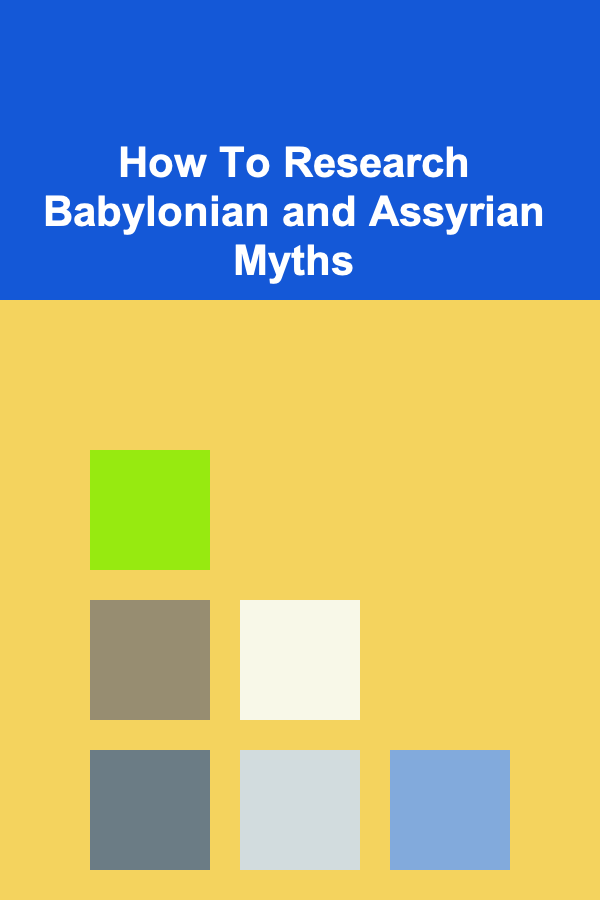
How To Research Babylonian and Assyrian Myths
ebook include PDF & Audio bundle (Micro Guide)
$12.99$9.99
Limited Time Offer! Order within the next:

Babylonian and Assyrian myths represent some of the most profound and ancient storytelling traditions in human history. The civilizations of ancient Mesopotamia produced a vast array of mythological narratives that not only reflected their religious beliefs but also shaped their culture, politics, and worldview. These myths are not only important for understanding the ancient civilizations themselves but also offer valuable insights into the origins of human imagination, ethics, and the understanding of the cosmos.
Researching Babylonian and Assyrian myths is a complex and fascinating task. It requires a multi-disciplinary approach that involves history, archaeology, linguistics, and comparative mythology. In this article, we will explore the steps and methods involved in researching these ancient myths, from understanding the primary sources to utilizing modern technologies and scholarly works.
Understanding the Historical Context of Babylonian and Assyrian Myths
1.1 The Importance of Context in Mythological Research
To truly grasp the meaning and significance of Babylonian and Assyrian myths, one must first understand the historical context in which these myths emerged. Babylon and Assyria were both powerful empires that rose in the fertile Mesopotamian region, which is now modern-day Iraq. These civilizations flourished between the 3rd and 7th centuries BCE, though their mythologies have roots that extend back thousands of years before that.
The Babylonians were known for their achievements in science, astronomy, and literature, while the Assyrians were a military powerhouse with a rich cultural tradition. Both cultures shared many gods, deities, and mythological motifs, though their interpretations and emphases differed.
Understanding the political and religious landscape of these civilizations is essential because their myths were often intertwined with their rulers, military conquests, and divine sanctioning of authority. For example, the Babylonian creation myth, the "Enuma Elish," is closely linked to the rise of the Babylonian king Marduk, while Assyrian mythology often revolved around the god Ashur and the kings' divine mandate to rule.
1.2 The Role of Religion in Babylonian and Assyrian Myths
Religion played a pivotal role in the mythological traditions of these civilizations. The gods were believed to control all aspects of life, from the fate of kings to the success of crops. Babylonian and Assyrian kings often presented themselves as chosen by the gods to lead their people. In this sense, understanding the religion of the time is crucial for interpreting myths.
In both Babylonian and Assyrian traditions, myths often described the origins of the world, the creation of humanity, the lives of the gods, and the nature of cosmic forces. These myths were typically passed down through oral traditions and later transcribed into written texts, often as part of royal inscriptions or religious rituals.
Identifying Primary Sources for Babylonian and Assyrian Myths
The most authentic way to research Babylonian and Assyrian myths is to study the primary sources---ancient texts that record the stories and myths of these civilizations. These texts are often found in cuneiform script, the writing system developed by the Sumerians and later adopted by the Babylonians and Assyrians.
2.1 The Importance of Cuneiform Tablets
Cuneiform tablets are the primary source for understanding the written records of Babylonian and Assyrian myths. These tablets were typically made of clay and inscribed with cuneiform symbols, often using reed styluses. The clay tablets were durable, and many of them have survived over the millennia, offering an invaluable glimpse into ancient mythological traditions.
The tablets were often stored in temples, royal palaces, or administrative centers, where scribes would transcribe myths, prayers, royal decrees, and other important documents. Key mythological texts, such as the "Epic of Gilgamesh," the "Enuma Elish," and the "Atrahasis," are found in cuneiform on these tablets.
2.2 Key Texts for Babylonian and Assyrian Myths
Some of the most important mythological texts for research on Babylonian and Assyrian myths include:
- Enuma Elish: The Babylonian creation myth that tells the story of the birth of the gods, the battle between Marduk and Tiamat, and the creation of the world from Tiamat's body.
- Epic of Gilgamesh: Perhaps the most famous piece of Babylonian literature, this epic follows the adventures of Gilgamesh, the king of Uruk, and his quest for immortality. It includes themes of friendship, the nature of life and death, and divine intervention.
- Atrahasis: This Akkadian epic details the story of the great flood, similar to the Biblical story of Noah's Ark, and addresses the themes of divine punishment and human survival.
- The Assyrian Royal Inscriptions: These inscriptions, found on palace walls and monuments, often contain references to Assyrian gods and their roles in the Assyrian king's military and political achievements.
These texts can be found in museums, libraries, and academic institutions, where scholars work to translate and interpret them. Many of these translations are now available in modern languages, making them accessible to researchers worldwide.
Translating and Interpreting Ancient Texts
3.1 The Challenges of Translating Cuneiform
Translating Babylonian and Assyrian texts from cuneiform is no easy task. The cuneiform script is composed of hundreds of symbols, each of which can have different meanings depending on the context. Additionally, the language used in these texts is quite different from modern languages, with complex grammatical structures and a range of dialects.
To translate cuneiform effectively, scholars must be well-versed in the ancient languages, including Akkadian, Sumerian, and Babylonian. Akkadian is the primary language used for most Babylonian and Assyrian texts, but Sumerian texts, which predate Akkadian, are also important for understanding the mythological traditions of Mesopotamia.
3.2 The Role of Comparative Mythology
Comparative mythology plays an important role in interpreting Babylonian and Assyrian myths. By comparing similar myths from different cultures, scholars can uncover common themes, archetypes, and motifs that transcend individual traditions. For instance, the flood myth found in both Babylonian and Assyrian myths has parallels in other ancient cultures, such as the Biblical story of Noah and the Greek myth of Deucalion.
Comparing these myths helps researchers identify the universal aspects of human storytelling, as well as the ways in which different societies adapted common themes to their own unique cultural and religious contexts.
Utilizing Modern Technology in Mythological Research
4.1 Digital Archives and Online Databases
With the advent of digital technology, researching Babylonian and Assyrian myths has become much easier. Many ancient cuneiform texts have been digitized and made available online through various archives and databases. These digital archives allow researchers to access high-resolution images of cuneiform tablets, translations, and scholarly commentary from anywhere in the world.
Notable resources include:
- The Cuneiform Digital Library Initiative (CDLI): A comprehensive online archive of cuneiform texts from various ancient Mesopotamian civilizations, including Babylonian and Assyrian.
- The British Museum: The British Museum holds one of the largest collections of Mesopotamian artifacts, including cuneiform tablets. Many of these artifacts are available online for study.
- The Electronic Text Corpus of Sumerian Literature (ETCSL): An important resource for scholars studying Sumerian literature, including myths and epics that influenced later Babylonian and Assyrian texts.
4.2 3D Imaging and Virtual Reconstructions
In recent years, technological advancements in 3D imaging and virtual reconstruction have allowed scholars to study cuneiform tablets and ancient artifacts in greater detail. 3D models of cuneiform tablets can be manipulated digitally, allowing researchers to zoom in on specific inscriptions, view tablets from different angles, and better interpret the text.
Virtual reconstructions of ancient cities and temples are also helpful in understanding the religious and cultural context in which these myths were created and performed. This technology offers a new way to experience and study ancient Mesopotamian culture.
Conducting Scholarly Research on Babylonian and Assyrian Myths
5.1 Academic Journals and Books
For in-depth research, consulting academic journals and books is essential. Many scholars have written extensively on Babylonian and Assyrian myths, and these works provide valuable insights into the interpretation and historical significance of the myths.
Key academic journals for mythological research include:
- The Journal of Near Eastern Studies
- The Journal of Cuneiform Studies
- Mesopotamia: The Journal of the Ancient Near East
Books by leading scholars in the field, such as "The Babylonian World" edited by Gwendolyn Leick and "The Assyrian Empire" by Amanda H. Podany, offer comprehensive overviews of the history, religion, and mythologies of these civilizations.
5.2 Fieldwork and Archaeological Discoveries
Finally, fieldwork and archaeological discoveries continue to play an essential role in researching Babylonian and Assyrian myths. Excavations in Mesopotamia have uncovered countless cuneiform tablets, inscriptions, and artifacts that provide new information about the myths and religious practices of these ancient civilizations.
Archaeological discoveries, such as the excavation of the ancient city of Nineveh, the capital of the Assyrian Empire, have provided a wealth of material for scholars studying Assyrian mythology.
Conclusion
Researching Babylonian and Assyrian myths requires a deep understanding of the historical, linguistic, and cultural context in which these myths were created. By studying primary sources, translating ancient texts, comparing myths across cultures, and utilizing modern technology, researchers can unlock the secrets of these ancient stories. The myths of the Babylonians and Assyrians continue to offer valuable insights into the worldview of these ancient civilizations and remain an essential part of human cultural heritage.

How to Build a Checklist for Conducting Project Meetings
Read More
How to Maintain and Care for Your Home's Outdoor Deck
Read More
How to Maximize Your Returns with Real Estate Investments
Read More
How to Save Money on Home Internet Security: Smart Solutions for Every Budget
Read More
How to Build Explosive Power
Read More
10 Quick Meditation Reminders for Your To-Do List
Read MoreOther Products

How to Build a Checklist for Conducting Project Meetings
Read More
How to Maintain and Care for Your Home's Outdoor Deck
Read More
How to Maximize Your Returns with Real Estate Investments
Read More
How to Save Money on Home Internet Security: Smart Solutions for Every Budget
Read More
How to Build Explosive Power
Read More